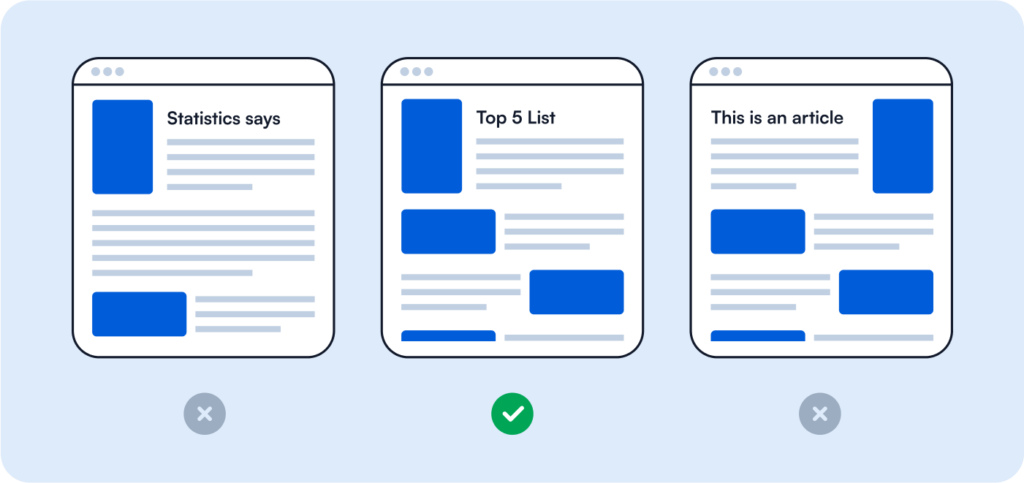How To Structure the Perfect Blog Post: A Guide for Boosting SEO and Reader Engagement

Writing is an art. Each writer brings a unique style when crafting their blogs. However, a blog’s structure can significantly impact its performance on search engines and its ability to engage readers. Across the internet, there are over 600 million active blogs, with two million produced daily and used in marketing. As such, it’s imperative to write one that stands out.
The publishers we collaborate with have varying degrees of selectiveness. But our overarching aim is to deliver uniform excellence across the board for every client. Our primary focus is crafting content that provides real value rather than merely serving as a vessel for client links.
Elements of the Perfect Blog Post
Think about it: Your goal is to develop content that’s truly useful to the readers, not just a webpage with links. With that in mind, here’s how you should structure your blog post:
Catch attention with a title

Your title or main headline will guide readers through what they can expect once they click on your article. It should have the primary keyword and promise value that is too good to pass up. A well-crafted title sets the stage for both SEO success and reader intrigue.
However, in an era when clickbait has become common, your priority should be setting the right expectations with your title. Crafting genuine titles is also about establishing trust and ensuring your content delivers its promises.
Avoid sensationalizing or exaggerating the benefits or insights provided in your post. If your title promises “10 Revolutionary Tips to Transform Your Writing,” ensure that your content truly delivers on that revolutionary promise.
Knowing what your audience is seeking can help you craft titles that resonate without resorting to clickbait tactics. Use language and themes that speak directly to their interests, challenges, or questions.
Your title should hint at the value readers will gain by engaging with your content, but always aim to deliver more than you promise. This over-delivery can take many forms, including additional insights, tips not mentioned in the title, and downloadable resources.
Feel free to experiment with different title formats and styles to see what resonates best. Use analytics to monitor engagement and adjust your approach based on actual data. Testing and refining your titles over time can help you discover the perfect balance between attractiveness and authenticity.
Engage with a strong introduction

Grab your readers’ attention from the get-go. Use the introduction to empathize with your audience, present a relatable problem, or pose a question. It sets the tone, establishes expectations, and decides whether your audience will stay engaged or leave the page. This is your opportunity to hook readers and give them a taste of the value awaiting them.
Think about it as making a lasting impression. Like in real life, you only have about seven seconds to leave that first impression. So you have to make it count and make it worthwhile.
Main body: deliver on your promise
Crafting the main body of an article is where your storytelling skills shine, blending informative content with engaging narrative.
Here are best practices to ensure your article’s main body is both informative and reader-friendly:

Use clear and concise headings
- Organize content: Add headings and subheadings to break down sections, making the article easier to scan and navigate. Make sure the headings follow the appropriate hierarchy.
- Be descriptive: Headings should accurately reflect the section’s content, using keywords where appropriate.
Ensure logical flow and coherence
- Logical progression: Arrange your points in a logical order, ensuring each section smoothly transitions to the next.
- Paragraph structure: The ideal structure should begin with a topic sentence. This should be followed with supporting sentences and a concluding sentence.

Incorporate evidence and examples
- Support claims: Use data, studies, and real-life examples to back up statements and add credibility. SearchEye recently launched a Q&A feature to help writers connect with industry leaders and add authenticity to their posts.
- Cite sources: Properly attribute quotes, statistics, and information to their sources.
Engage the reader
- Use active voice: Active voice makes your article more direct and dynamic.
- Tell stories: Where appropriate, use storytelling to illustrate points and engage readers emotionally.

Visual elements and formatting
- Incorporate visuals: Use images, charts, and infographics to complement the text and illustrate key points.
- Use bullet points and lists: Bullet points or numbered lists make the information more digestible when enumerating items or sharing some tips.
Keep it accessible and inclusive
- Use simple language: Avoid jargon and complex terms, or explain them if necessary.
- Inclusive language: Be mindful of diversity and strive for inclusive language for all readers.
Encourage action with a strong conclusion

An effective conclusion is key to leaving a lasting impression on your readers. It should wrap up your article cohesively, reinforce your main points, and encourage further thought or action. Here’s how to craft a conclusion that resonates:
Summarize key points
- Recap the essentials: Briefly summarize your article’s central themes or findings without repeating all the details.
- Reinforce the message: Emphasize the main takeaway you want readers to remember.
Reflect on the implications
- Broaden the perspective: Discuss the broader implications of the information shared. What does it mean for the future? How does it affect the reader or the subject matter at large?
- Connect the dots: Show how the pieces of your article fit together to form a comprehensive understanding of the topic.
Offer a call to action (CTA)
- Encourage action: Suggest steps the reader can take next, whether it’s to learn more through additional resources, apply the information in their own lives, or engage with a community or service.
- Be specific and relevant: Tailor your CTA to your article’s content and your audience’s interests.
Pose questions or a challenge
- Stimulate thinking: Leave your readers with a question or a challenge that encourages them to reflect on the topic further.
- Invite engagement: Questions can also prompt readers to comment, fostering a community of discussion around your article.
Provide a forward-looking statement
- Look ahead: Offer predictions, upcoming trends, or future developments related to your article’s topic.
- Inspire optimism or caution: Depending on the content, end with hope and excitement for the future or a cautionary reminder of the challenges ahead.
Best Practices for Writing

Here are the best practices to elevate your blog writing and ensure your posts stand out:
Write for readability
Keep paragraphs short. Aim for two to three sentences per paragraph to make your post easier to scan. Use bullet points or numbered lists. They’re great for summarizing information or illustrating steps in a process. It’s also good to mix short and long sentences to keep the rhythm of your writing engaging.
Optimize for SEO
Do keyword research, and make sure to use these keywords naturally. Add relevant keywords in the title, headings, and content without overdoing it. Remember to optimize meta descriptions and title tags: Write meta descriptions and title tags that include your primary keyword to improve search engine visibility.
Add internal links, but make sure they’re relevant to your content. This motivates visitors to delve deeper, aiding website indexing and enhancing SEO performance.
Edit and proofread
Always review your work. Check for clarity, grammar, and spelling errors. Editing tools like Grammarly can be helpful. Have someone else review your post to catch mistakes you might have missed.
Promote your post

Leverage social media. Let your audience know about your recent post. When you receive a comment, take time to reply to show appreciation and build a community around your blog.
Engage the Marketplace
Standing out from the crowd demands a strategic approach to ensure your posts gain the visibility and authority they deserve. One effective method to achieve this is by leveraging SearchEye’s Marketplace. Our platform offers a unique opportunity to enhance your content’s reach and significantly boost its position in search engine rankings. With our high-quality links and mentions through SearchEye, you’re increasing traffic to your site and establishing a stronger online presence.
Elevate Your Content Strategy with SearchEye
With a solid foundation for crafting the perfect blog posts, it’s time to take your content strategy further with SearchEye. Explore our tools and marketplace to boost your content’s reach and engagement. Let’s work together to reshape your digital footprint and achieve measurable results.
With SearchEye, optimizing your blog posts for search engines and engaging readers becomes not just a goal but a reality. With us, every post is a step towards success.

